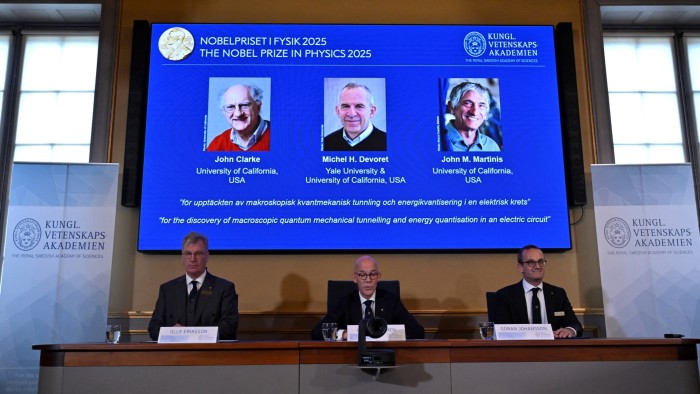Unlock the Editor’s Digest for free
Roula Khalaf, Editor of the FT, selects her favourite stories in this weekly newsletter.
John Clarke, Michel H Devoret and John M Martinis have won the Nobel Prize in physics for the discovery of quantum mechanical effects that lay the ground for a potential new generation of powerful computers, sensors and encryption technology.
The three researchers will share SKr11mn ($1.17mn) for showing how strange quantum phenomena could be exploited in real-world electronic devices, the Nobel Assembly said on Tuesday as it announced the second of its three annual science awards.
“It is wonderful to be able to celebrate the way that century-old quantum mechanics continually offers new surprises,” said Olle Eriksson, chair of the Nobel committee for physics. “It is also enormously useful, as quantum mechanics is the foundation of all digital technology.”
All three researchers are affiliated with US institutions. Clarke is at University of California, Berkeley, Devoret at Yale University and University of California, Santa Barbara, and Martinis at University of California, Santa Barbara.
“My feelings are that I am completely stunned, of course,” said Clarke, speaking by voice call to the audience at the award announcement at the Royal Swedish Academy of Sciences in Stockholm. “It had never occurred to me in any way that this might be the basis of a Nobel Prize.”
Quantum technologies exploit how the behaviour of matter at the scale of atoms and their constituent particles can differ sharply from that of everyday objects.
Quantum effects underpin modern electronics, in components such as the transistors in microchips in computers and mobile phones.
The prize-winners showed how the “bizarre properties of the quantum world can be made concrete in a system big enough to be held in the hand”, the awards committee said.
The honour recognises groundbreaking experiments carried out by the three researchers in 1984 and 1985, including an investigation of a quantum mechanical effect called tunnelling.
Tunnelling on the submicroscopic scale of the quantum world allows particles to move through physical barriers. The analogy in human experience would be if a tennis ball thrown against a wall went straight through it.
The scientists showed tunnelling and other quantum effects could take place in a circuit made from superconductors, which can conduct electric current with no electrical resistance.
This provides a basis for efforts to develop new quantum technologies. These include sensors to locate objects underground and computers to perform calculations beyond state-of-the-art existing machines.
“This year’s physics prize is about putting quantum mechanics, which we know from the subatomic world . . . on to an electrical circuit on a chip,” said Göran Johansson, an awards committee member, as he brandished a disc embedded with electronics in illustration. “It’s really a discovery that opened up our understanding for how quantum physics can appear also on this scale.”
The 124-year-old Nobel awards were set up according to the will of Alfred Nobel, a Swedish scientist and businessman who invented dynamite. The physics prize winner is chosen by a special committee at the Royal Swedish Academy of Sciences.
On Monday, Mary E Brunkow, Fred Ramsdell and Shimon Sakaguchi won the Nobel in Physiology or Medicine for discoveries about the regulation of the human immune system. The chemistry award is due to be announced on Wednesday.
Read the full article here




